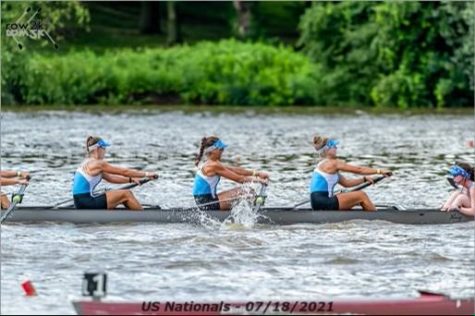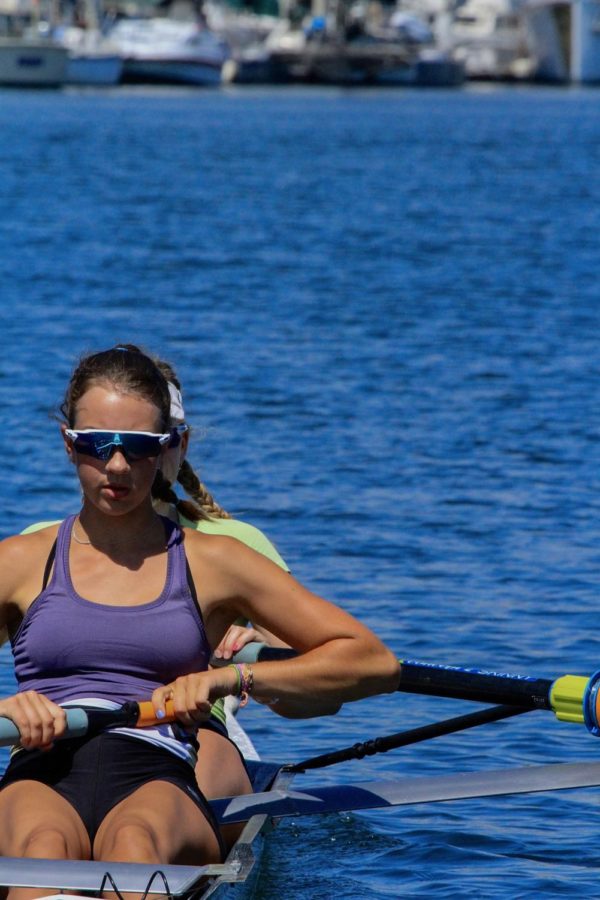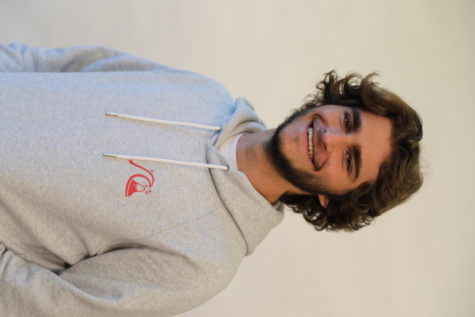Crew Unto Others as You Would Have Them Crew Unto You: Tracing Rower Tessa Tomkinson’s Routine, Accomplishments and Relationships Through her Crew Career
Senior Tessa Tomkinson competes for NorCal women’s varsity crew. She will crew for Brown University next year. Photo courtesy of Tessa Tomkinson.
April 21, 2022
Early bird gets the worm
Before Menlo students are fighting for parking spots, before their morning Coffee Bar runs and before they even wake up, senior Tessa Tomkinson has already finished her athletics practice. Tomkinson is a rower, committed to Brown University, and she’s on the water before the sun even rises.
Rowing is a sport built on precision and swiftness, qualities apparent in Tomkinson’s morning routine. “My first alarm goes off at 4:23, then at 4:30 and 4:45. I snooze all of them until 4:52, and then I get up,” the rower said. “I have everything laid out the night before, so my morning routine is very streamlined. I put on my unisuit, a t-shirt and another layer.”
Tomkinson then heads downstairs to the kitchen at 5:02. “I make my two Eggo waffles with peanut butter and syrup. While I do that, I braid my hair.” Tomkinson eats her waffles as she drives to practice and arrives at 5:22 for a 5:30 start time. She rows at Bair Island Aquatic Center in Redwood Shores.
A Baker’s Dozen
Tomkinson didn’t begin rowing until she was 13. While DI athletes often begin their sports at a much earlier age, Tomkinson says it’s normal to start rowing as a teenager. “13 is pretty much the earliest you can start. It has a lot of strain on your body, and the most common injury is in your back from the repetitive motion. So it’s better to wait until your body has developed a little bit more when you’re older.”
The senior got into rowing at an introductory camp. “I did a summer camp at the club I row at where you learn the basics — that’s how most people get into it too.” she said.
Tomkinson found the camp at a good time. After seven years of swimming, she was ready for a change. “I was a swimmer, and I hated it. But I still wanted to participate in a sport or hunt for a new one, so I was exploring a range of sports camps the summer before eighth grade. I was a little stressed out, since everyone seemed to already play most sports at 13, but that wasn’t the case for rowing.”
Rowing is also a popular sport for people to walk onto their college varsity team. Both of Tomkinson’s parents walked on at their respective colleges. “I’ve found a lot of people have some sort of connection to rowing. Like their parents rowed like mine. A lot of people walk on at college because it’s not a super popular sport, and it’s faster to pick up than other sports as long as you have an athletic base. So for a lot of people, they have it on their radar when they begin as a teenager or if they walk on at college,” Tomkinson said.
This rings true for some of Tomkinson’s teammates. Charlotte Jett, a sophomore at Sequoia high school, has been rowing for three years. She joined the sport because her mom rowed in college.
Just Crew It
When someone joins a crew team for the first time, they row in the novice boat. “You do one year of novice, which is basically like JV. That’s where you’re just learning and then you all move on to the varsity equivalent in crew,” Tomkinson said. The rower has been with NorCal Crew for her whole career. With her club, she has six practices per week with Monday through Thursday running from 5:30 to 7:30, Fridays in the afternoon and a four hour morning practice on Saturdays.
The emphasis on morning practices is a unique aspect of crew. “In this area specifically, it gets really windy in the afternoon, so it’s harder to get in a solid practice because of how choppy the water gets,” Tomkinson said. “That sort of just extends to crew clubs around the country — mornings are just a common thing.”
While it may seem early for most people, the Brown commit has become accustomed to rising before the sun. “I honestly don’t mind it. It lets me get on with my afternoon. I still wouldn’t call myself a morning person, though. I can’t wake up if it’s for school or something, but for some reason I can for practice.” Tomkinson enjoys starting her day with a workout and believes it helps her come to school awake and prepared.
Nonetheless, Tomkinson still goes to bed at 10:30 on a good day, meaning she averages around six hours of sleep. “It’s probably not as early as it should be. It’s difficult because my family likes to go to bed late so that pushes my schedule back.”
Luckily, Tomkinson is very into naps. “I don’t know how much it really does for me since I don’t think it makes up for REM sleep, but it makes me feel better.”
Crunch Crew, Crunch Time
Tomkinson is currently in the spring season, the busiest time of the year for rowers. “We usually have around six or seven races in the spring. I would best compare it to track where you have a handful of meets, but it may not seem like a lot to people who play soccer or some more popular sports.”

While rowing is a year-round sport, the spring season is the most important because the national championship and shorter style races — such as the 2000 meters — are held. During the fall, longer races — such as the 5000 meters — and fewer races take place. In the winter, many East Coast clubs have to train inside on ergs because of the snowfall. “Most crews take the winter to get in shape for the big season, so it’s definitely not the offseason.”
Clubs have to travel all over the country to compete together. Tomkinson most recently competed in a tournament in Long Beach in which her club placed third in women’s varsity out of eight teams. NorCal Crew will compete next in the San Diego Crew Classic through the weekend of March 25. “It’s usually a performance just to get to the races since we have a big team. We have varsity men, varsity women, novice men and novice women, so it’s a lot of people to move.”
Besides the people, the club also has to move the equipment too. “There’s the whole aspect of transporting the boat. Basically you have to take certain parts of the boat off and pack them in a certain way in a trailer. Pretty much the only way to get them anywhere is to drive them. So for each race, you need a couple of days for prep and then a couple days to unload,” Tomkinson said.
While the San Diego tournament is an important race, involving many teams and college recruiters, the next tournament in May is Tomkinson’s biggest of the season. NorCal Crew will compete against all the clubs from California and some surrounding southwest states. Based on how well they perform, they may qualify for nationals in Sarasota, Florida in June. “The races are usually pretty tight, especially in the [style] that we’re racing in,” Tomkinson’s teammate and best friend Eliza Bulanti, a senior at St. Francis, said. “The top three teams are usually a second away from each other. You have to find what is going to put you an extra second ahead.”
Crew-ships
“I’m personally really close with my team. I spend a ton of time with them, and I also think rowing can be a pretty painful sport. We do workouts that can hurt a lot, so I think that bonds us together too. I’ve also been on a team with the girls for five years, so we’ve gone through a lot together,” Tomkinson said.
Bulanti emphasized the importance of teamwork when it comes to forming relationships with her fellow rowers. “Everything we do has to be done as a team. It’s not like other sports where everyone has different positions. We all have to work together all the time.”
Tomkinson’s teammate Marrisa Chow, a junior at carlmont, emphasized this level of cooperation and coordination as a crew. “You need to be in sync and together. It’s an intense sport where you meet people who want to push themselves as hard as you do,” Chow said.
Jett looks to Tominkson as one of those teammates who pushes the team. “So when you have people like that, people like Tessa, it’s hard not to form a personal relationship with them,” Jett said.
In fact, Bulanti, Jett and Chow all highlighted Tomkinson as a passionate leader ready to push her team and celebrate their wins. “She’s very competitive in the best way possible,” Jett said. “She just sets the standard high.”
Bulanti, who has rowed with Tomkinson on NorCal Crew for all five years, pointed out Tomkinson’s leadership and optimism. “She’s not afraid to say when something’s wrong and when we need to set higher standards for ourselves. But she’s also the first one to get excited and celebrate our wins. She’s always so supportive and always shows up everyday in practice to get better,” Bulanti said.
“She puts forth so much dedication and unmatched effort — it’s obvious she wants to win and do her best,” Chow said.
Bulanti believes the shared dedication and commitment is why Tomkinson forges such strong bonds with her teammates. “Everyone chooses to show up every day. We didn’t fall into the same place; we all choose to show up and work hard, so we share a lot of similar values.”
College Re-crew-tment
Tomkinson didn’t always know she wanted to row in college, although she was aware that recruiting is very common in crew clubs. “I think there’s a misconception that it’s easier to get recruited for rowing, which isn’t necessarily true. There’s just a smaller pool of high school athletes than more popular college sports, so a higher number of rowers end up committing,” Tomkinson said.
Right as Tomkinson began seriously considering the recruitment process, COVID-19 struck, halting all races. Recruiting requires sending coaches race results and personal bests, so without races, the whole process seemed pointless. However, the more Tomkinson sat without rowing, the more she realized she missed it. “I decided around summer [of 2020] that I really wanted to do this. Once the season was canceled, I realized I really missed it.”
Tomkinson feels more comfortable going into her freshman year of college with a group of girls she knows she will connect with. She’s also excited for the routine and structure that rowing adds to her life. “My sister is a runner and she talks about a ‘runner’s high,’ and there’s a similar feeling with rowing. Like when you’re having a really good workout, and you just feel satisfied. I think that feeling is what you’re always chasing, just the satisfaction I get after a job well done.”



